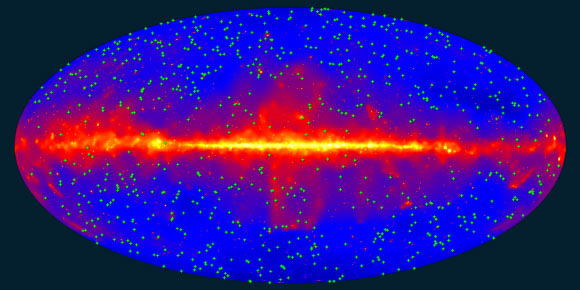Astronomers believe that our Universe began forming the first stars when it was a few hundred million years old. Since then, the Universe has become a star-making tour de force. There are now about two trillion galaxies and a trillion-trillion stars. Using new methods of starlight measurement, astronomers analyzed data from NASA’s Fermi Gamma-ray Space Telescope to determine the history of star formation over most of the Universe’s lifetime.

This map of the entire sky shows the location of 739 blazars used in NASA’s Fermi Gamma-ray Space Telescope’s measurement of the extragalactic background light. The background shows the sky as it appears in gamma rays with energies above 10 billion electron volts, constructed from nine years of observations by Fermi’s Large Area Telescope. The plane of our Milky Way Galaxy runs along the middle of the plot. Image credit: NASA / DOE / Fermi LAT Collaboration.
One of the main goals of the Fermi mission was to assess the extragalactic background light (EBL), a cosmic fog composed of all the ultraviolet, visible and infrared light stars have created over the Universe’s history.
“From data collected by the Fermi telescope, we were able to measure the entire amount of starlight ever emitted,” said Dr. Marco Ajello, an astrophysicist at Clemson University.
“Most of this light is emitted by stars that live in galaxies. And so, this has allowed us to better understand the stellar-evolution process and gain captivating insights into how the Universe produced its luminous content.”
Dr. Ajello and co-authors analyzed almost nine years of data pertaining to gamma-ray signals from 739 blazars.
“Blazars are galaxies containing supermassive black holes that are able to release narrowly collimated jets of energetic particles that leap out of their galaxies and streak across the cosmos at nearly the speed of light,” they explained.
“When one of these jets happens to be pointed directly at Earth, it is detectable even when originating from extremely far away.”
Gamma ray photons produced within the jets eventually collide with the cosmic fog, leaving an observable imprint.
This enabled the astronomers to measure the density of the fog not just at a given place but also at a given time in the history of the Universe.
“Gamma rays are the highest-energy form of light. They are so energetic, in fact, that their interactions with starlight have unusual consequences. When the right frequencies of light collide, they can convert into matter through Albert Einstein’s famous equation E=mc2,” said Dr. Alberto Dominguez, an astrophysicist at Complutense University of Madrid.
“Gamma-ray photons traveling through a fog of starlight have a large probability of being absorbed,” Dr. Ajello added.
“By measuring how many photons have been absorbed, we were able to measure how thick the fog was and also measure, as a function of time, how much light there was in the entire range of wavelengths.”
According to the new measurement, the number of photons — particles of visible light — that escaped into space after being emitted by stars translates to 4*1084.
“By using blazars at different distances from us, we measured the total starlight at different time periods,” said Dr. Vaidehi Paliya, a postdoctoral researcher at Clemson University.
“We measured the total starlight of each epoch — one billion years ago, two billion years ago, six billion years ago, etc — all the way back to when stars were first formed.”
“This allowed us to reconstruct the EBL and determine the star-formation history of the Universe in a more effective manner than had been achieved before.”
The study was published in the journal Science.
_____
S. Abdollahi et al. (The Fermi-LAT Collaboration). 2018. A gamma-ray determination of the Universe’s star formation history. Science 362 (6418): 1031-1034; doi: 10.1126/science.aat8123







